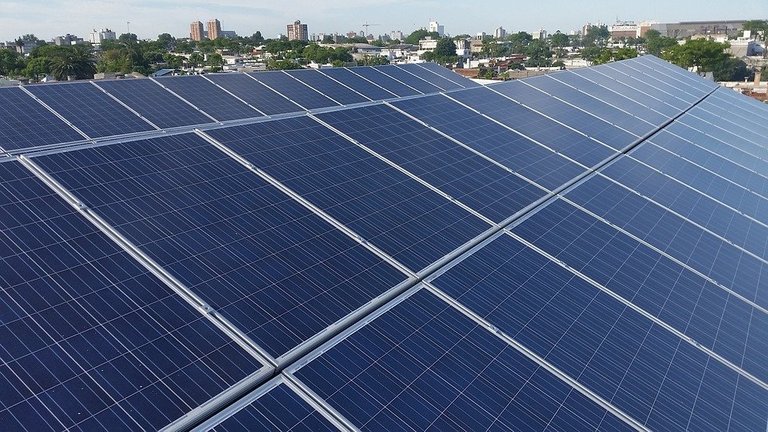Potential of collective photovoltaic self-consumption
The production of electricity through the installation of photovoltaic solar cells is nothing new, and self-consumption through these systems provides clean energy to our homes, which can help us reduce electricity consumption from the public grid and combat climate change. But these systems require large surfaces for the installation of the panels, so the installation of photovoltaic systems in public or residential buildings, for collective self-consumption, emerges as an interesting option to the traditional energy model.

Self-consumption of energy through solar panels has always been a great alternative for energy management. Source: pixabay.com.
While many governments are moving forward in the decarbonization of the electricity system, not all are moving at the same speed and in the same direction, so large-scale solutions may still take a long time to arrive, but citizens can take an active part in solving the problem with our actions, and one of these can be to promote the use of renewable energies. Let's keep in mind that we are consuming more and more electricity, acquiring more devices that require energy, mobiles, tablets, computers, cars, among others; so the origin of the electricity we consume is something to which we should pay more importance, and at an individual level, one of the best alternatives to reduce CO2 emissions into the atmosphere are photovoltaic energy systems.
As we well know, self-consumption through a photovoltaic system serves to harness solar energy and transform it into electricity through the use of solar panels and various electronic components that control and distribute the generation of energy; and anyone with enough space in their home is able to generate their own energy.

Any home with enough space can generate photovoltaic energy. Source: piqsels.com.
And when we talk about collective photovoltaic self-consumption, as its name suggests, we refer to a group of owners or neighbors who share a photovoltaic installation to supply their energy needs. This model has many advantages over an individual self-consumption system, the most obvious being that the investment per owner is lower than if each owner invested in their own system.
On the other hand, the installation of solar cells for residential self-consumption benefits people who do not have access to a large rooftop, and this model of shared energy generation and consumption puts communities at the center of the energy model, allowing many more people to access clean energy.
What are the other benefits of shared self-consumption?
By implementing the combination of clean energy production and a shared self-consumption model, we can find other benefits:
- We will advance in achieving more sustainable cities, electricity generation through solar panels is one of the cleanest technologies, thus contributing to the reduction of greenhouse gas emissions and mitigating climate change.
- By generating photovoltaic energy in installations close to our homes, it allows for less dependence on the public grid and large electric companies, which represents a saving in the cost of the electricity bill.
- In addition, these systems do not produce noise pollution, an important problem that is affecting the quality of life of people in large cities.
- Another important point is that the components of photovoltaic systems are recoverable and recyclable.
Shared self-consumption in residential buildings
A photovoltaic installation can have different uses in a residential building, it could be an installation intended to cover the common needs of the inhabitants, such as elevators and lighting of the stairs, corridors and parking, or it could be an integral installation, intended to cover the energy needs of the homes of the associates.
In the case of the second option, the production of the photovoltaic energy can be distributed by agreement among the members, setting the distribution coefficient among them, which can be according to the amount of power of the system or according to the investment of each one.

Self-consumption of energy can be shared in residential buildings. Source: Image edited in powerpoint, original from pixabay.com.
In conclusion, photovoltaic solar self-consumption is a good model of citizen energy management, which has a positive impact not only on the utility bill but also reduces greenhouse gas emissions, helping users to be less dependent on electric companies.
Thanks for coming by to read friends, I hope you liked the information. See you next time.
This has served as cost reduction and also made electricity constant which reduce the rate of depending on electric companies. Its great checking out your post it worth the time. Thanks for sharing
Hi friend, I'm glad you liked the post, it's definitely a good way to reduce costs and dependence on the electric companies.
oh, sun energy is getting more and more popularity hetre, even in my small city. I saw dozens of houses and hotels with them. And I dream to have my own house with them too;)
Hello friend, it really is a very popular alternative, I also dream of installing my own system someday.
Collective photovoltaic self-consumption has significant potential to revolutionize energy use in communities. By sharing solar energy generated from a common source, groups of people can reduce individual costs and environmental impacts. This system not only promotes sustainable energy but also empowers communities to be more energy-independent. A key element is that participants can optimize their solar usage with various modern tech add-ons, like an utv sound bar which provides entertainment options using clean energy. As this trend grows, it underscores the importance of accessible and efficient solar solutions for all.
Posted using STEMGeeks
The British Photovoltaic industry has seen remarkable growth as the UK embraces solar energy to meet its sustainability goals. With advancements in technology and government incentives, British Photovoltaic solutions are now more accessible and efficient than ever. Solar panels are increasingly installed on homes and businesses, reducing reliance on traditional energy sources. This shift is not only cutting carbon emissions but also making renewable energy a practical, long-term solution for the UK.
Posted using STEMGeeks